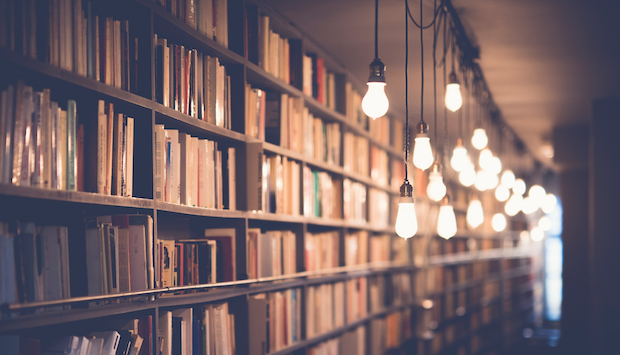A couple weeks ago, I wrote a post about the technology of Scripture study in the Middle Ages. In it, I explained how medieval monks and scholars approached Scripture as an organic aspect of the living Tradition. The Bible was understood primarily within a liturgical context, and it was studied primarily within a paradigm of memorization in which the Scripture text, along with its glosses, was incorporated into the believer’s very personality. In the typical Bible, the text was literally surrounded by the texts of the tradition, and Scripture’s primary existence was in the hearts and minds of the living Church—there was no hard line between Scripture and Tradition, past and present.
To the thinkers of the Middle Ages, the present was simply a continuation of the periods that had preceded it—they understood history as continuity. The Renaissance humanists, however, posited a historical narrative of rupture. To these scholars, the accomplishments of the ancient Greeks and Romans represented the pinnacle of civilization. From those heights, the West had descended into a thousand years of barbarity, and the humanists saw themselves as pulling Christendom up from this decline, from these “middle ages” (as they called the period), again to the level of the ancients.
 This movement was primarily literary in orientation, and the humanists were obsessed with language. They found medieval Latin crude and championed, instead, the formal, intricate style of the classical rhetoricians. They studied this style and emulated it and, in doing so, contributed to the fossilization of Latin, to its conversion from a living to a dead language. After the Renaissance, the Latin taught throughout Europe was the language of a bygone age, of Cicero, rather than the living language of the contemporary Church.
This movement was primarily literary in orientation, and the humanists were obsessed with language. They found medieval Latin crude and championed, instead, the formal, intricate style of the classical rhetoricians. They studied this style and emulated it and, in doing so, contributed to the fossilization of Latin, to its conversion from a living to a dead language. After the Renaissance, the Latin taught throughout Europe was the language of a bygone age, of Cicero, rather than the living language of the contemporary Church.
This rupture, this passing over of the Middle Ages, was manifested in the manner in which scholars approached texts. Scholars of the Middle Ages tended to approach texts as participants in a perpetual dialogue. For example, they studied Roman Law because it was understood to enshrine timeless truths of legal reason, truths that had immediate application. The Renaissance scholars, on the other hand, tended to approach texts as artifacts of a distant past. They were far less interested in what Roman Law could tell them about political reality and far more interested in what the Roman code could tell them about the Romans, about the time and place in which it was written. They were interested in historical context, in the shifting meaning of words, in the scientific study of the text as a text. If the scholars of the Middle Ages sought, through meditation, to bring literary texts into their own personalities, Renaissance scholars sought to push the texts away from themselves, seeking an objective vantage point from which to dissect them and understand them on their own terms.
The biblical scholars of the period approached Scripture in the same way. They sought the pure text—the text as it had been originally written—and the meaning within its historical context. The medieval Bibles, filled with illuminations, and bursting with the centuries’ glosses, gave way to the scientific text; of what objective value, after all, were the thoughts of some random eight-century monk? Rather, what the Renaissance scholars wanted was Scripture as it had been composed—both its text and its meaning. They turned to the Greek and Hebrew, studying the Bible more as a historical text than as a living, liturgical utterance. And so the glossed Bibles faded away and were replaced by such seminal marvels as the Complutensian Polyglot and Erasmus’ Greek New Testament.
This movement corresponded exactly with the invention of the printing press. Whereas in the Middle Ages, each Bible was the unique manifestation of sometimes centuries of tradition, the printing press could produce thousands of identical copies. This demanded a single text, a fundamental text that could serve as the printers’ source. Such a technological need was directly congruent with the humanist approach to historical texts, and so the humanists set to work producing critical editions, taking into account the various manuscript traditions, reconciling them, sorting out what they deemed to be corruptions from later ages, and finally producing the “text” as they supposed it to have been written. This text was printed, translated, and disseminated as a stand-alone book, without glosses or adornment. It was the Bible in this form that would become “the Bible” as we tend to think of it today. But its development was not complete. The tradition and liturgical aspects of the Scripture may have been removed from the physical book, but the fight over these facets of the Christian heritage was only just beginning, and it was over the course of the Reformation that the conceptions of Scripture that corresponded to its new form would definitively take shape—but this is a topic for another post.







Thank you for the post!
Enjoying this series Andrew, thanks for these. I use Logos every day but got here through your FreeRepublic post, kinda funny. As I was reading this post to my wife she commented that, in her opinion, today’s post-modernists seem to be moving back to a more experiential, personalized experience of the Middle Ages. Nothing new under the sun indeed. Blessings.
Aaargh! Great insight but now I have to wait for the “rest of the story”. Hope its coming soon. Reminds me of the post Vatican II spirit of discontinuity. Didn’t realize this had its roots much further back. Do we have the glosses anywhere?
Glosses are on most medieval Bibles. The “ordinary gloss” as it had developed by the late Middle Ages was printed a few times during the Renaissance. For example, there is a 1603 edition here. A facsimile of a 1480/1 edition has been published as Biblia latina cum glossa ordinaria: Facsimile reprint of the Editio Princeps (Adolph Rusch of Strassburg 1480/81). There is a very bad edition in volumes 113 and 114 of the Patrologia Latina series. Also there are a group of scholar’s in France working on a producing a digital edition, here.
[…] his follow-up post on the Renaissance approach to textual studies, Jones makes another important point. The flowering of humanism led people away from the medieval […]